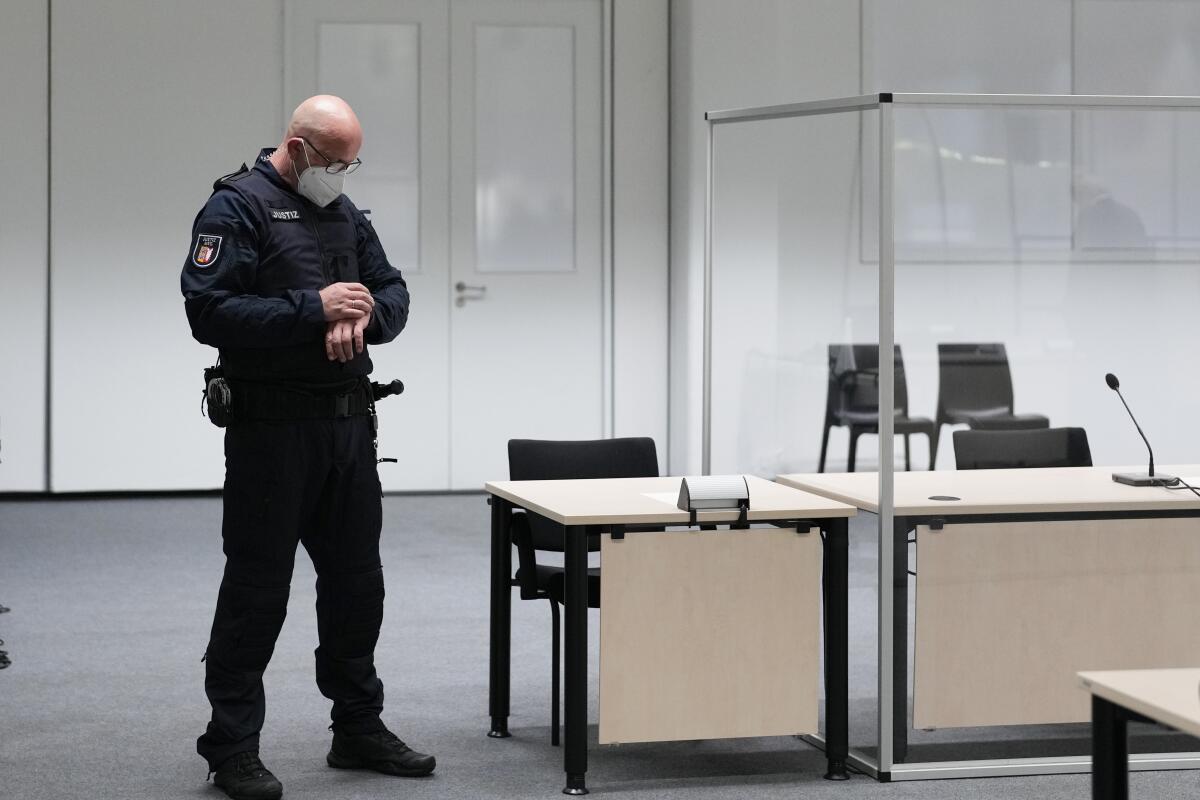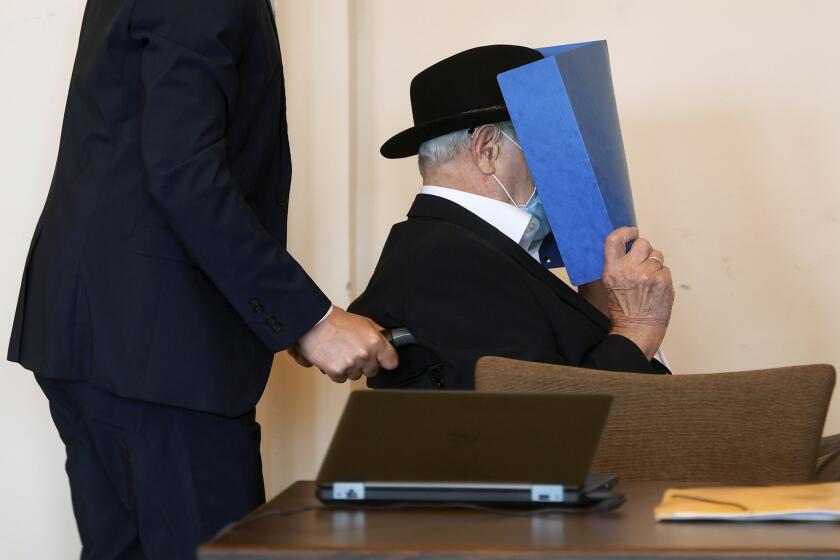96-year-old ex-aide to Nazi camp commander is caught after failing to show up for trial

BERLIN — A former secretary to the commander of a Nazi concentration camp skipped the planned start Thursday of her trial in Germany on more than 11,000 counts of accessory to murder, officials said. She was picked up several hours later after the court issued an arrest warrant.
The 96-year-old woman left her home near Hamburg in a taxi Thursday morning a few hours before proceedings were due to start at the state court in Itzehoe, court spokesperson Frederike Milhoffer said.
The court issued the warrant and delayed the reading of the indictment until the next scheduled hearing Oct. 19 because it couldn’t be done in the defendant’s absence.
The accused woman previously had “announced that she didn’t want to come” to court, but her statement did not provide sufficient grounds for detaining her ahead of the trial, Milhoffer said. Given the woman’s age and condition, she had not been expected “actively to evade the trial,” Milhoffer added.
The court said Thursday afternoon that the defendant had been caught and that police would bring her to court, German news agency DPA reported. A doctor was to examine whether she was fit to be jailed before the court decides whether or not to put her in custody.
Prosecutors argue that the woman was part of the apparatus that helped the Nazis’ Stutthof camp function more than 75 years ago.
A German court has convicted a 93-year-old former SS private of being an accessory to murder at the Stutthof concentration camp during World War II.
The state court said in a statement before the trial that the woman allegedly “aided and abetted those in charge of the camp in the systematic killing of those imprisoned there between June 1943 and April 1945 in her function as a stenographer and typist in the camp commandant’s office.”
Despite her advanced age, the German woman will be tried in juvenile court because she was under 21 at the time of the alleged crimes. The defendant has been widely identified by German media as Irmgard Furchner.
Efraim Zuroff, the head Nazi hunter at the Simon Wiesenthal Center’s office in Jerusalem, said the defendant had claimed in a recent letter to the court that she was too frail to appear for trial.
“Apparently, that’s not exactly the case,” he said.
“If she is healthy enough to flee, she is healthy enough to be incarcerated,” Zuroff told the Associated Press. Her flight, he added, “should also affect the punishment.”
The detention centers where the U.S. government has held migrant children have sparked widespread outrage.
The case against Furchner will rely on German legal precedent established in cases over the past decade that anyone who helped Nazi death camps and concentration camps function can be prosecuted as an accessory to the murders committed there, even without evidence of participation in a specific crime.
A lawyer for the defendant told Der Spiegel magazine that the trial would center on whether the 96-year-old had knowledge of the atrocities that happened at the camp.
“My client worked in the midst of SS men who were experienced in violence — however, does that mean she shared their state of knowledge? That is not necessarily obvious,” Wolf Molkentin said.
According to other media reports, the defendant was questioned as a witness during past Nazi trials and said at the time that the former SS commandant of Stutthof, Paul Werner Hoppe, dictated daily letters and radio messages to her. Still, Furchner testified that she was not aware of the killings that occurred at the camp while she worked there, the German news agency DPA reported.
Breaking News
Get breaking news, investigations, analysis and more signature journalism from the Los Angeles Times in your inbox.
You may occasionally receive promotional content from the Los Angeles Times.
Initially a collection point for Jews and non-Jewish Poles removed from Danzig — now the Polish city of Gdansk — Stutthof from about 1940 was used as a so-called work education camp where forced laborers, primarily Polish and Soviet citizens, were sent to serve sentences and often died.
From mid-1944, tens of thousands of Jews from ghettos in the Baltics and from Auschwitz filled the camp, along with thousands of Polish civilians swept up in the brutal Nazi suppression of the Warsaw uprising.
Others incarcerated there included political prisoners, accused criminals, people suspected of being gay and Jehovah’s Witnesses.
More than 60,000 people were killed there, some by being given lethal injections of gasoline or phenol directly to their hearts, or being shot or starved. Others were forced outside in winter without clothing until they died of exposure, or were put to death in a gas chamber.
In a separate case, a 100-year-old man is going on trial next week in Brandenburg for allegedly serving as a Nazi SS guard at a concentration camp just outside Berlin during World War II.
The man, whose name wasn’t released because of German privacy laws, is charged with 3,518 counts of accessory to murder. The suspect is alleged to have worked at the Sachsenhausen camp between 1942 and 1945 as an enlisted member of the Nazi Party’s paramilitary wing.
More to Read
Sign up for Essential California
The most important California stories and recommendations in your inbox every morning.
You may occasionally receive promotional content from the Los Angeles Times.












